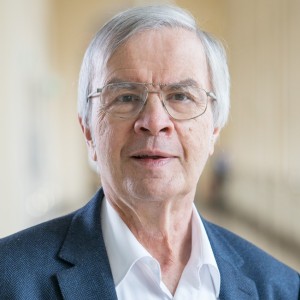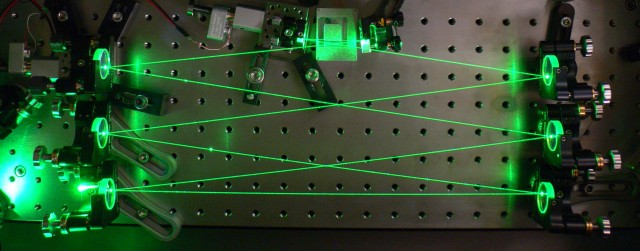
Near-ultraviolet photon-counting dual-comb spectroscopy
B. X. Xu, Z. J. Chen, T. W. Hänsch, N. Picqué
Nature 19 (2024).
Ultraviolet spectroscopy provides unique insights into the structure of matter with applications ranging from fundamental tests to photochemistry in the Earth's atmosphere and astronomical observations from space telescopes1-8. At longer wavelengths, dual-comb spectroscopy, using two interfering laser frequency combs, has become a powerful technique capable of simultaneously providing a broad spectral range and very high resolution9. Here we demonstrate a photon-counting approach that can extend the unique advantages of this method into ultraviolet regions where nonlinear frequency conversion tends to be very inefficient. Our spectrometer, based on two frequency combs with slightly different repetition frequencies, provides a wide-span, high-resolution frequency calibration within the accuracy of an atomic clock, and overall consistency of the spectra. We demonstrate a signal-to-noise ratio at the quantum limit and an optimal use of the measurement time, provided by the multiplexed recording of all spectral data on a single photon-counter10. Our initial experiments are performed in the near-ultraviolet and in the visible spectral ranges with alkali-atom vapour, with a power per comb line as low as a femtowatt. This crucial step towards precision broadband spectroscopy at short wavelengths paves the way for extreme-ultraviolet dual-comb spectroscopy, and, more generally, opens up a new realm of applications for photon-level diagnostics, as encountered, for example, when driving single atoms or molecules. We demonstrate a photon-counting approach that extends the unique advantages of spectroscopy with interfering frequency combs into regions where nonlinear frequency conversion tends to be very inefficient, providing a step towards precision broadband spectroscopy at short wavelengths and extreme-ultraviolet dual-comb spectroscopy.

Improved active fiber-based retroreflector with intensity stabilization and a polarization monitor for the near UV (vol 29, pg 7024, 2021)
V. Wirthl, L. Maisenbacher, J. Weitenberg, A. Hertlein, A. Grinin, A. Matveev, R. Pohl, T. W. Hänsch, T. Udem
Optics Express 30 (5), 7340-7341 (2022).
In Sec. 6 (polarization monitor) of our recent publication [Opt. Express 29(5), 7024 (2021)], we assumed a small value of delta. This is however incorrect. The correct approximation for small beta leads to the updated Eqs. (10)-(11), resulting in a corrected Fig. 12. (C) 2022 Optica Publishing Group under the terms of the Optica Open Access Publishing Agreement

Improved active fiber-based retroreflector with intensity stabilization and a polarization monitor for the near UV
V. Wirthl, L. Maisenbacher, J. Weitenberg, A. Hertlein, A. Grinin, A. Matveev, R. Pohl, T. W. Hänsch, T. Udem
Optics Express 29 (5), 7024-7048 (2021).
We present an improved active fiber-based retroreflector (AFR) providing high-quality wavefront-retracing anti-parallel laser beams in the near UV. We use our improved AFR for first-order Doppler-shift suppression in precision spectroscopy of atomic hydrogen, but our setup can be adapted to other applications where wavefront-retracing beams with defined laser polarization are important. We demonstrate how weak aberrations produced by the fiber collimator may remain unobserved in the intensity of the collimated beam but limit the performance of the AFR. Our general results on characterizing these aberrations with a caustic measurement can be applied to any system where a collimated high-quality laser beam is required. Extending the collimator design process by wave optics propagation tools, we achieved a four-lens collimator for the wavelength range 380-486 nm with the beam quality factor of M-2 similar or equal to 1.02, limited only by the not exactly Gaussian beam profile from the single-mode fiber. Furthermore, we implemented precise fiber-collimator alignment and improved the collimation control by combining a precision motor with a piezo actuator. Moreover, we stabilized the intensity of the wavefront-retracing beams and added in-situ monitoring of polarization from polarimetry of the retroreflected light. (C) 2021 Optical Society of America under the terms of the OSA Open Access Publishing Agreement

Two-photon frequency comb spectroscopy of atomic hydrogen
A. Grinin, A. Matveev, D. C. Yost, L. Maisenbacher, V. Wirthl, R. Pohl, T. W. Hänsch, T. Udem
Science 370 (6520), 1061-+ (2020).
We have performed two-photon ultraviolet direct frequency comb spectroscopy on the 1S-3S transition in atomic hydrogen to illuminate the so-called proton radius puzzle and to demonstrate the potential of this method. The proton radius puzzle is a significant discrepancy between data obtained with muonic hydrogen and regular atomic hydrogen that could not be explained within the framework of quantum electrodynamics. By combining our result [f(1s-3s) = 2,922,743,278,665.79(72) kilohertz] with a previous measurement of the 1S-2S transition frequency, we obtained new values for the Rydberg constant [R-infinity = 10,973,731.568226(38) per meter] and the proton charge radius [r(p) = 0.8482(38) femtometers]. This result favors the muonic value over the world-average data as presented by the most recent published CODATA 2014 adjustment.

Photon-level broadband spectroscopy and interferometry with two frequency combs
N. Picqué, T. W. Hänsch
Proceedings of the National Academy of Sciences of the United States of America 117 (43), 26688-26691 (2020).
We probe complex optical spectra at high resolution over a broad span in almost complete darkness. Using a single photon-counting detector at light power levels that are a billion times weaker than commonly employed, we observe interferences in the counting statistics with two separate mode-locked femtosecond lasers of slightly different repetition frequencies, each emitting a comb of evenly spaced spectral lines over a wide spectral span. Unique advantages of the emerging technique of dual-comb spectroscopy, such as multiplex data acquisition with many comb lines, potential very high resolution, and calibration of the frequency scale with an atomic clock, can thus be maintained for scenarios where only few detectable photons can be expected. Prospects include spectroscopy of weak scattered light over long distances, fluorescence spectroscopy of single trapped atoms or molecules, or studies in the extreme-ultraviolet or even soft-X-ray region with comb sources of low photon yield. Our approach defies intuitive interpretations in a picture of photons that exist before detection.


